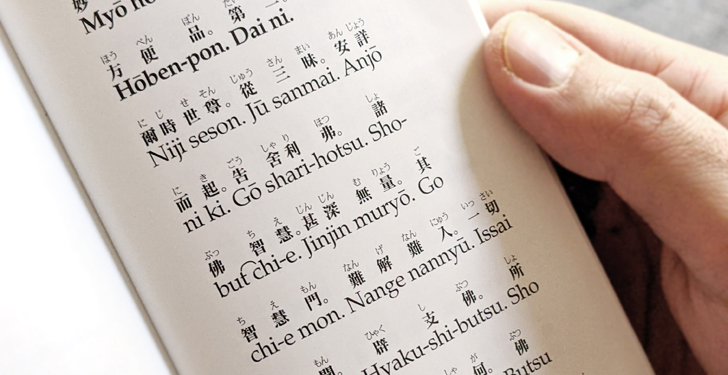In his book The Heart of the Lotus Sutra, Ikeda Sensei details the significance and meaning of “Expedient Means” and “Life Span of the Thus Come One,” the 2nd and 16th chapters of the Lotus Sutra, which we recite in our daily practice of gongyo.
This week, let’s study what Sensei says about the following lines from the “Expedient Means” chapter.
Sho-but chi-e. Jinjin muryo.
Go chi-e mon. Nange nannyu.
The wisdom of the Buddhas is infinitely profound and immeasurable. The door to this wisdom is difficult to understand and difficult to enter.
(The Lotus Sutra and Its Opening and Closing Sutras, p. 56)
The “wisdom of the Buddhas” is the wisdom that shines like a sun within the Buddha. Shakyamuni praises this wisdom as “infinitely profound and immeasurable.” It is “infinitely profound” because it penetrates down to the truth that is the very foundation of life. It is “immeasurable” because its light broadly illuminates all things.
Because the wisdom of the Buddhas reveals life in its entirety, the Buddha’s state of life is said to be expansive and profound. …
Shakyamuni doesn’t praise the wisdom of the Buddhas to say that the Buddha alone is great. In fact, it is just the opposite; his purpose is to encourage others. In effect, he is saying, “Therefore, all of you, too, should make this same great wisdom of the Buddhas shine in your own lives and become happy.”
Wisdom is the path to happiness. Money, status, skill at getting by in the world—none of these can enable us to overcome the fundamental sufferings of birth, old age, sickness and death. The only way is to cultivate the wisdom with which our lives are inherently endowed.
The Lotus Sutra’s purpose is to enable all people to cultivate supreme wisdom in their hearts and advance along the great path of indestructible happiness. …
The next part of the passage reads, “The door to this wisdom is difficult to understand and difficult to enter.” Here Shakyamuni again praises the Buddha wisdom but from a slightly different perspective.
The “door to this wisdom” is the door to the realm of Buddha wisdom. Shakyamuni expounded various teachings as the means to enable people to enter this realm. … Prior to the Lotus Sutra, he taught in accordance with his listeners’ diverse capacities. … Shakyamuni expounded teachings that the people could best understand.
These specific teachings, however, did not represent the Buddha’s true purpose. The true purpose lay in enabling all people to enter the path of wisdom, the path for becoming a Buddha. This purpose, however, cannot be understood with the wisdom of voice-hearers or cause-awakened ones.Voice-hearers and cause-awakened ones: Called persons of the two vehicles, unlike bodhisattvas, they seek their own emancipation without thought of preaching for and instructing others. The realm of voice-hearers is the seventh of the Ten Worlds, sometimes called the world of learning, and the realm of caused-awakened ones is the eighth of the Ten Worlds, sometimes called the world of realization. Voice-hearers hear the Buddha’s preaching and strive to attain enlightenment. Cause-awakened ones, also known as pratyekabuddhas, perceive the truth of causal relationships (12-linked chain of causation).[/ref Such people may understand the contents of a particular teaching, but they cannot fathom the Buddha’s reason for expounding it.
Their very satisfaction with specific teachings—ones that explain life’s impermanence or the need to eradicate desires, for instance—prevented them from entering the realm of the wisdom of the Buddha who had expounded these doctrines. They reached the gate, as it were, and then stopped. Therefore, Shakyamuni says this wisdom is “difficult to understand and difficult to enter.”
Regard Suffering and Joy as Facts of Life
I have discussed until now the literal or surface meaning of this passage. …
As Nichiren Daishonin says, “‘wisdom’ means the Wonderful Law” (The Record of the Orally Transmitted Teachings, p. 29). Nam-myoho-renge-kyo, the “Wonderful Law,” contains the infinitely profound and immeasurable wisdom of the Buddhas in its entirety. And the door to enter the wisdom of Nam-myoho-renge-kyo is the door of faith. Thus the Daishonin says, “The door is the mind of faith” (OTT, 26).
If we believe in the Gohonzon and exert ourselves in practice and study as the Daishonin teaches, then, in accordance with the principle of substituting faith for wisdom, we can develop a state of supreme happiness. This is what it means to enter through the door of faith, to advance along the path of attaining Buddhahood in this lifetime.
Carrying through with faith becomes difficult, however, when we encounter waves of adversity. At such times, people may forget that faith is the door to wisdom. Instead, filled with complaint, they may be tossed about helplessly on the rough seas of their problems. Or they may fear suffering and give themselves over to lives of pleasure and ease. In this sense, the door of faith is “difficult to understand and difficult to enter.”
For precisely this reason, Nichiren says, “Regard both suffering and joy as facts of life, and continue chanting Nam-myoho-renge-kyo” (“Happiness in This World,” The Writings of Nichiren Daishonin, vol. 1, p. 681).
Nam-myoho-renge-kyo is the wellspring of the wisdom of all Buddhas. And our daily gongyo is a ceremony of beginningless time in which we return to the very foundation of our lives and draw wisdom from the great ocean of the world of Buddhahood. (The Heart of the Lotus Sutra, pp. 30–33)
You are reading {{ meterCount }} of {{ meterMax }} free premium articles

